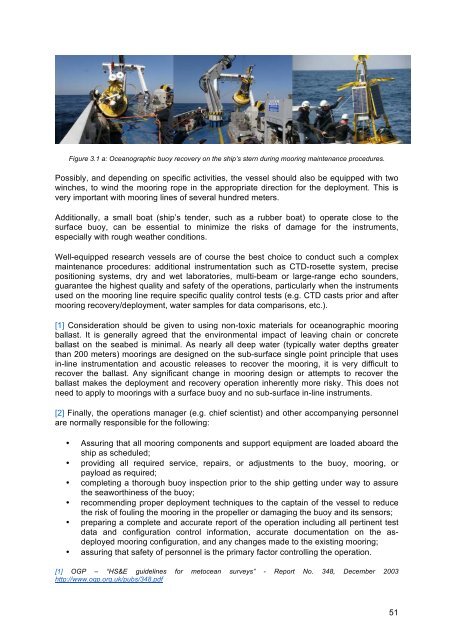Handbook of best practices
Handbook%20of%20best%20practices
Handbook%20of%20best%20practices
Create successful ePaper yourself
Turn your PDF publications into a flip-book with our unique Google optimized e-Paper software.
Figure 3.1 a: Oceanographic buoy recovery on the ship’s stern during mooring maintenance procedures.<br />
Possibly, and depending on specific activities, the vessel should also be equipped with two<br />
winches, to wind the mooring rope in the appropriate direction for the deployment. This is<br />
very important with mooring lines <strong>of</strong> several hundred meters.<br />
Additionally, a small boat (ship’s tender, such as a rubber boat) to operate close to the<br />
surface buoy, can be essential to minimize the risks <strong>of</strong> damage for the instruments,<br />
especially with rough weather conditions.<br />
Well-equipped research vessels are <strong>of</strong> course the <strong>best</strong> choice to conduct such a complex<br />
maintenance procedures: additional instrumentation such as CTD-rosette system, precise<br />
positioning systems, dry and wet laboratories, multi-beam or large-range echo sounders,<br />
guarantee the highest quality and safety <strong>of</strong> the operations, particularly when the instruments<br />
used on the mooring line require specific quality control tests (e.g. CTD casts prior and after<br />
mooring recovery/deployment, water samples for data comparisons, etc.).<br />
[1] Consideration should be given to using non-toxic materials for oceanographic mooring<br />
ballast. It is generally agreed that the environmental impact <strong>of</strong> leaving chain or concrete<br />
ballast on the seabed is minimal. As nearly all deep water (typically water depths greater<br />
than 200 meters) moorings are designed on the sub-surface single point principle that uses<br />
in-line instrumentation and acoustic releases to recover the mooring, it is very difficult to<br />
recover the ballast. Any significant change in mooring design or attempts to recover the<br />
ballast makes the deployment and recovery operation inherently more risky. This does not<br />
need to apply to moorings with a surface buoy and no sub-surface in-line instruments.<br />
[2] Finally, the operations manager (e.g. chief scientist) and other accompanying personnel<br />
are normally responsible for the following:<br />
• Assuring that all mooring components and support equipment are loaded aboard the<br />
ship as scheduled;<br />
• providing all required service, repairs, or adjustments to the buoy, mooring, or<br />
payload as required;<br />
• completing a thorough buoy inspection prior to the ship getting under way to assure<br />
the seaworthiness <strong>of</strong> the buoy;<br />
• recommending proper deployment techniques to the captain <strong>of</strong> the vessel to reduce<br />
the risk <strong>of</strong> fouling the mooring in the propeller or damaging the buoy and its sensors;<br />
• preparing a complete and accurate report <strong>of</strong> the operation including all pertinent test<br />
data and configuration control information, accurate documentation on the asdeployed<br />
mooring configuration, and any changes made to the existing mooring;<br />
• assuring that safety <strong>of</strong> personnel is the primary factor controlling the operation.<br />
[1] OGP – “HS&E guidelines for metocean surveys” - Report No. 348, December 2003<br />
http://www.ogp.org.uk/pubs/348.pdf<br />
51


